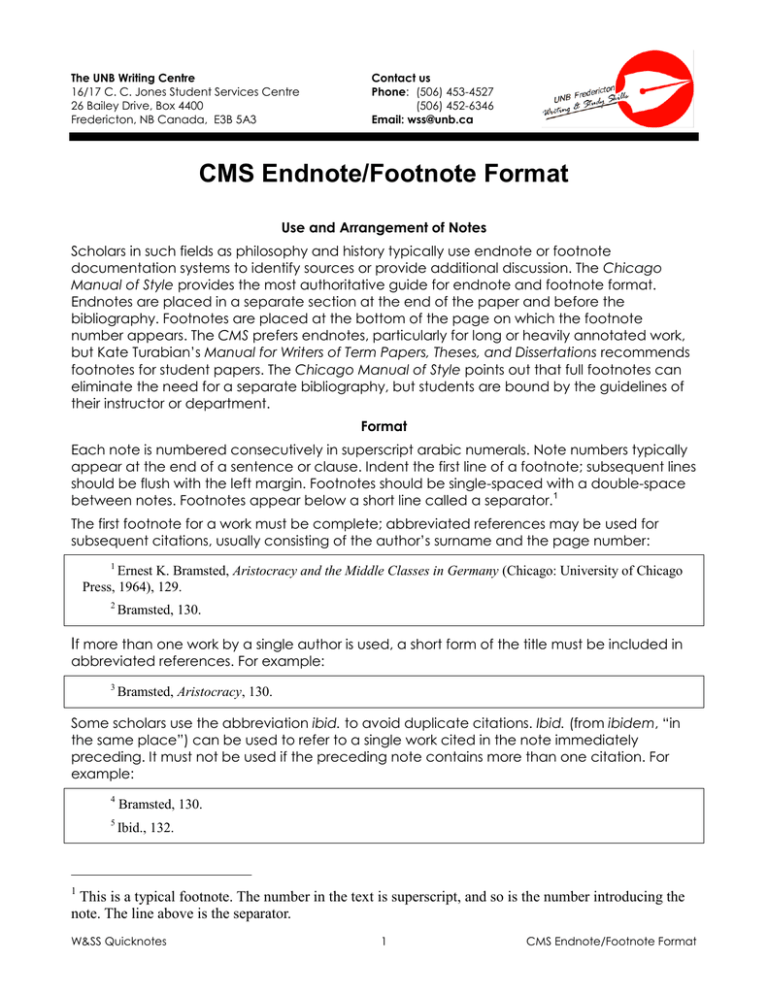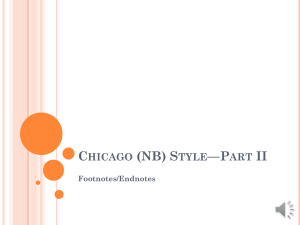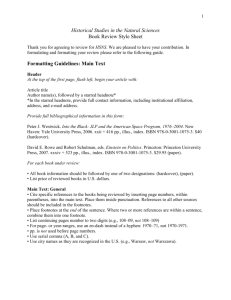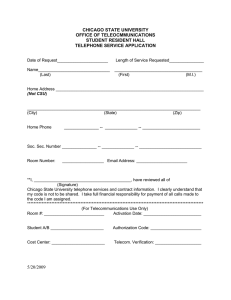CMS Endnote/Footnote Format Guide
advertisement

The UNB Writing Centre 16/17 C. C. Jones Student Services Centre 26 Bailey Drive, Box 4400 Fredericton, NB Canada, E3B 5A3 Contact us Phone: (506) 453-4527 (506) 452-6346 Email: wss@unb.ca CMS Endnote/Footnote Format Use and Arrangement of Notes Scholars in such fields as philosophy and history typically use endnote or footnote documentation systems to identify sources or provide additional discussion. The Chicago Manual of Style provides the most authoritative guide for endnote and footnote format. Endnotes are placed in a separate section at the end of the paper and before the bibliography. Footnotes are placed at the bottom of the page on which the footnote number appears. The CMS prefers endnotes, particularly for long or heavily annotated work, but Kate Turabian’s Manual for Writers of Term Papers, Theses, and Dissertations recommends footnotes for student papers. The Chicago Manual of Style points out that full footnotes can eliminate the need for a separate bibliography, but students are bound by the guidelines of their instructor or department. Format Each note is numbered consecutively in superscript arabic numerals. Note numbers typically appear at the end of a sentence or clause. Indent the first line of a footnote; subsequent lines should be flush with the left margin. Footnotes should be single-spaced with a double-space between notes. Footnotes appear below a short line called a separator.1 The first footnote for a work must be complete; abbreviated references may be used for subsequent citations, usually consisting of the author’s surname and the page number: 1 Ernest K. Bramsted, Aristocracy and the Middle Classes in Germany (Chicago: University of Chicago Press, 1964), 129. 2 Bramsted, 130. If more than one work by a single author is used, a short form of the title must be included in abbreviated references. For example: 3 Bramsted, Aristocracy, 130. Some scholars use the abbreviation ibid. to avoid duplicate citations. Ibid. (from ibidem, “in the same place”) can be used to refer to a single work cited in the note immediately preceding. It must not be used if the preceding note contains more than one citation. For example: 4 Bramsted, 130. 5 Ibid., 132. 1 This is a typical footnote. The number in the text is superscript, and so is the number introducing the note. The line above is the separator. W&SS Quicknotes 1 CMS Endnote/Footnote Format Students are urged to use Ibid. with caution to ensure that the term is not separated from its reference. Two other abbreviations—op. cit. (from opera citato, “in the work cited”) and loc. cit. (from loco citato, “in the place cited”)—are falling out of favour because they require readers to search through previous notes to find the original citation. Multiple Citations in a Single Note Consolidating multiple references into a single note can help to reduce the number of citations. Separate the citations with semi-colons and make sure the citations appear in the same order as the text material. For example: Walter Sutton, “The Analysis of Free Verse Form, Illustrated by a Reading of Whitman,” Journal of Aesthetics and Art Criticism 18 (December 1959): 241-54; Paul Fussell, “Whitman‟s Curious Warble: Reminiscence and Reconciliation,” in The Presence of Walt Whitman, ed. R. W. B. Lewis (New York: Columbia University Press, 1962), 28-51; and John Lovell, “Appreciating Whitman: „Passage to India,‟” Modern Language Quarterly 21 (June 1960): 131-41. 6 Sample Notes The following examples illustrate some of the most common citations. Consult the Chicago Manual of Style for scenarios not illustrated below. The numbers contained in the brackets link to the location of that example in the Chicago Manual of Style, 16th ed. Books # Author‟s first name last name, “Title of the Part of the Book,” Title of Book, editor or translator, edition used, Title of Series and volume number, (City of Publication: Publisher‟s name, year of publication), page(s) referred to. Books: Single author (14.75) 7 Ernest K. Bramsted, Aristocracy and the Middle Classes in Germany (Chicago: University of Chicago Press, 1964), 129. Books: Two or three authors (14.76) 8 Timothy Brook, Jerome Bourgon, and Gregory Blue, Death By a Thousand Cuts (Cambridge, MA: Harvard University Press, 2008), 76-77. Books: More than three authors (14.76) 9 Jeri A. Sechzer et al., eds., Women and Mental Health (Baltimore: Johns Hopkins University Press, 1996), 243. Books: Author plus an editor or translator (14.88) 10 Yves Bonnefoy, New and Selected Poems, eds. John Naughton and Anthony Rudolf (Chicago: University of Chicago Press, 1995). 11 Pierre Goubet, The Ancien Règime: French Society, 1600-1750, trans. Steve Cox (New York: Harper, 1973), 102. Books: Author unknown (14.79) 12 A True and Sincere Declaration of the Purpose and Ends of the Plantation Begun in Virginia, of the Degrees Which It Hath Received, and Means By Which It Hath Been Advanced (London, 1610). Books: Organization as author (14.92) W&SS Quicknotes 2 CMS Endnote/Footnote Format 14 University of Chicago Press, The Chicago Manual of Style, 16th ed. (Chicago: University of Chicago Press, 2010), 699. 15 World Health Organization, Health Needs of Adolescents, WHO Technical Reports no. 607 (Geneva: World Health Organization, 1977), 10-15. Books: Part of a book (14.111 and 14.116) Neil MacKinnon, “The Changing Attitudes of the Nova Scotian Loyalists towards the United States, 1873-1791,” in The Acadiensis Reader: Atlantic Canada Before Confederation, ed. P.A. Buckner and David Frank, 2nd ed. (Fredericton: Acadiensis, 1990), 1: 109. 21 22 S. F. C. Milsom, introduction to The History of English Law, by Sir Frederick Pollock and Frederick William Maitland, 2nd ed. (Cambridge: Cambridge University Press, 1968), 1: xliv. Books: Subsequent and revised editions (14.118) 16 William Strunk, Jr. and E. B. White, The Elements of Style, 4th ed. (New York: Allyn and Bacon, 2000). 17 Florence Babb, Between Field and Cooking Pot: The Political Economy of Marketwomen in Peru, rev. ed. (Austin: University of Texas Press, 1989), 199. Books: Reprints (14.119) 18 Christopher Dawson, The Making of Europe: An Introduction to the History of European Unity (1932, reprint, New York: World, 1952), 24. Books: Multi-volume works; the example below cites the eighth volume.(14.121-2) 19 William Kingsford, The History of Canada (Toronto: Roswell & Hutchison, 1887-1898), 8: 324. Books: Part of a series (14.128) 20 Larry Gragg, A Quest for Security: The Life of Samuel Parris, 1653-1720, Contributions in American History no. 142 (New York: Greenwood, 1990), 207. Articles Author‟s first name last name, “Title of the article,” Title of Periodical, Volume number in Arabic numerals, (year of publication), page(s) referred to. # Articles: Scholarly journal with volume number (14.180) Paul W. Schroeder, “Did the Vienna Settlement Rest on a Balance of Power?” American Historical Review 97 (1992): 694. 23 Articles: Scholarly journal with issue number and volume number (14.180) Roger Pearson, “Chieftainship as an Evolutionary Stage in the Transition from Tribal to Feudal Society,” Mankind Quarterly 28, no. 2 (1987): 142. 24 Articles: Scholarly journal with issue number only (14.180) 25 J. M. Beattie, “The Pattern of Crime in England, 1660-1800, Past and Present, no. 62 (1974): 47-95. Note: The example below shows two possible short citations for a journal article. The colon used in a full citation is replaced with a comma for a short citation. 26 Pearson, “Chieftainship as an Evolutionary Stage,” 142. 27 Beattie, 91. Articles: Book review (14.215) W&SS Quicknotes 3 CMS Endnote/Footnote Format 28 Lewis L. Gould, review of Franklin D. Roosevelt: A Rendezvous with Destiny, by Frank Friedel, American Historical Review 97 (1992): 309. Articles: Newspaper article (14.203-7) Note: If using contemporary articles from titles that publish multiple editions in a single day, CMS recommends omitting page numbers, in case the article is moved in subsequent editions. CMS adds the city (and the state, if needed) to American titles unless the newspaper has a national profile, such as the Wall Street Journal or Christian Science Monitor. For other newspapers, including British and Canadian, CMS recommends adding the city of publication in parentheses after the title, i.e. The Times (London) or Globe and Mail (Toronto). 29 “Israel, Egypt Call for Peace Talks This Year,” Saint John Telegraph-Journal, February 28, 1987, 3. 30 “Suspected Poisonings,” The Times (London), August 20, 1846, 5. 30 Kevin Walker, letter to the editor, Daily Gleaner (Fredericton), March 3, 2011, 4. Articles: Magazine article (14.199) 31 Ken Auletta, “The Heiress: The Rise of Elisabeth Murdoch,” New Yorker, December 10, 2012: 50-59. Government Publications See sections 14-293-308. 32 Economic Council of Canada, Reforming Regulation (Ottawa: Economic Council of Canada, 1981), 49. 33 Great Britain, Central Office of Information, Britain 1970: An Official Handbook (London: Her Majesty‟s Stationery Office, 1970), 23. 34 New Brunswick, Task Force on Social Development, Participation and Development, Report 1 (Fredericton: Queen‟s Printer, 1971), 102. Theses and Dissertations See section 14.244. Christopher T. Hustwick, “The Amateur Solicitor in Eighteenth-Century England: John Cannon of West Lydford and Glastonbury, 1684-1743,” (master‟s thesis, University of Victoria, 1988), 17. 35 Mihwa Choi, “Contesting Imaginaires in Death Rituals during the Northern Song Dynasty,” (PhD diss., University of Chicago, 2008), ProQuest (AAT 3300426), 236. 36 On-line sources Author‟s first name last name, “Title of the Site/Article,” [Title of Periodical,] [Print publication information, page] [Database, Database Publisher] [URL if a website source]. # Note: Rules for electronic sources remain more flexible than those applied to traditional published media. Sources found in databases such as JSTOR should identify the database used, and increasingly, digital object identifiers (DOIs) are used. Book with a printed source (14.166) 37 Charles Dickens, A Christmas Carol in Prose: Being a Ghost Story of Christmas (London, 1879), 4546, http://ota.ahds.ac.uk/3256.html. Journal/Newspaper article with a printed source (14.184-5) Downing, Ben. “Psalmanazar the Amazing.” Yale Review 90 no. 3 (2002): 74. doi: 10.1111/0044 -124.00621. 38 W&SS Quicknotes 4 CMS Endnote/Footnote Format Ioan Grillo, “Why Cartels Are Killing Mexico‟s Mayors,” New York Times, January 15, 2016, http://www.nytimes.com/2016/01/17/opinion/sunday/why-cartels-are-killing-mexicos-mayors.html 39 Note: The CMS recommends that line breaks in DOIs and URLs be placed before a slash, swing tilde, period, comma, hyphen, or underline. Journal/Conference article without a printed source (14.184-5) Camille Langston, “Resistance and Control: The Complex Process of Creating an OWL,” Kairos: A Journal for Teaching Writing in Webbed Environments 1, no.1 (1996), http://english. ttu.edu/kairos/1.1. 39 W. L. Godshalk, “Re: Funeral Elegy,” February 10, 1996, http://www.shaksper.net/archives /1996/0214.html. 40 Personal or professional website (14.244) 41 Brooks, Ronald J. “Homepage,” March 31, 2003, http://www.uoguelph.ca/~rjblab/RonBrooksNT.htm. Archival Sources See sections 14.232-40. Note that published sources consulted at an archive are treated as publications. However, unpublished archival material is treated differently. Archival entries for unpublished sources must include the name of the archive; the name of the collection; the record group; the volume, box and/or file number; the microfilm reel number (if applicable); item description; and date. For example: 42 National Archives of Canada, Remezay Family Collection, MG18 H54, vol. 4, p. 1708, microfilm C15684, commission as commander of troops, May 28, 1699. Note: In the Chicago Manual of Style, two citation styles are differentiated: one for notes and one for bibliographies. For notes (footnotes or endnotes), the main element of a primary source citation is usually a specific item, which is cited first. If the specific item lacks a formal title, you may create one (e.g., photograph, telegram, minutes, etc). These non-specific titles should not be italicized or enclosed in quotations. For example: 43 Memorandum by Alvin Johnson, 1937, file 36, Horace Kallen Papers, YIVO Institute for Jewish Research, New York. You can use a short form for further citations from the same source if after you cite it the first time you state, in brackets, that you will be referring to the source in a specific way: 44 Memorandum by Alvin Johnson, 1937, file 36, Horace Kallen Papers, YIVO Institute for Jewish Research, New York (hereafter cited as Kallen Papers). 45 Memorandum, 1937, file 36, Kallen Papers. Note: If no date is specified for the item you are citing, then n.d. is used in lieu of the date. Personal Interviews (see section 14.219) 43 C. S. Lewis, telephone interview, May 22, 1961. Audiobooks (see section 14.277) Dylan Thomas, Under Milk Wood, performed by Dylan Thomas et al., Caedmon TC-2005, 1953, 33⅓ rpm, 2 LPs. 44 45 Eric Schlosser, Fast Food Nation: The Dark Side of the All-American Meal, read by Rick Adamson (New York: Random House Audible, 2004), audiobook, 8 compact discs; 9 hrs. Films (see section 14.279) 46 North by Northwest, directed by Alfred Hitchcock (1959; Burbank, CA: Warner Home Video, 2000), DVD. W&SS Quicknotes 5 CMS Endnote/Footnote Format
![[title] Writing a Research Paper](http://s2.studylib.net/store/data/015952607_1-a24021a8b99597e61da77de3c7ee9906-300x300.png)


